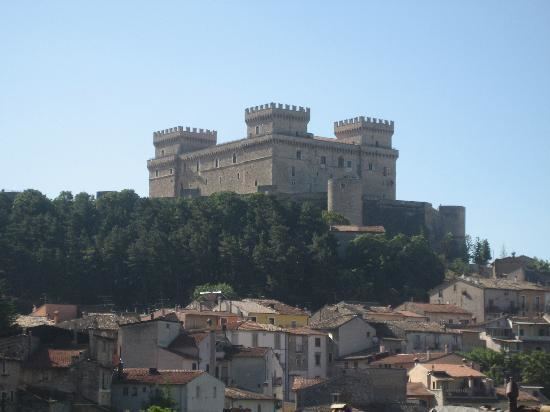Demonym(s) Celanesi Local time Tuesday 9:54 AM | Elevation 850 m (2,790 ft) | |
 | ||
Frazioni Borgo Quattordici, Borgo Ottomila Weather 4°C, Wind NW at 10 km/h, 84% Humidity Points of interest Castello Piccolomini, Museo d'Arte Sacra del, Gole di Celano, L'Isola che non cè | ||
Celano l aquila abruzzo il paese castello piccolomini canyon di celano slideshow
Celano is a town and comune in the Province of L'Aquila, central Italy, 120 km (75 mi) east of Rome by rail.
Contents
- Celano l aquila abruzzo il paese castello piccolomini canyon di celano slideshow
- Map of Celano Province of LAquila Italy
- Geography
- History
- Main sights
- Culture and sport
- Notable people
- References
Map of Celano, Province of L'Aquila, Italy
Geography
Celano rises on the top of a hill in the territory of Marsica, below the mountain range of Sirente. It faces the valley of Fucino, once filled by the large Fucine Lake, which was drained during the 19th century.
History
After the fall of the Western Roman Empire, Celano suffered from the invasions of Lombards (6th century). The city passed under Byzantine control, and was then subdued by the Lombards and governed by the duchies of Spoleto and Benevento.
From the 8th century, Charlemagne and his descendants ruled the Marsica region independently of Spoleto, raising it to the rank of county. Celano was elected Caput Marsorum (capital city of the Marsica region), governed by the Berardi family. From around the year 1140, it was captured by the Normans, who annexed it to the Kingdom of Sicily. Fearing that Marsica was becoming too powerful, in the year 1223 Emperor Frederick II ordered his army to destroy the castles of the region. Celano suffered a long siege, which ended with its defeat and total destruction and the exile of its entire male population to Sicily and Malta. Once the feudal rights of Celano were abolished the region came under the jurisdiction of the Giustizierato of Abruzzo, with Sulmona as capital.
After the intercession of the Pope Honorius III, Emperor Frederick II authorised the inhabitants to return from exile. The new city was rebuilt three years after its destruction, about one kilometre from the ancient city. Celano reflourished and was once again governed by the Berardi family.
After a series of struggles between the Angevins and Aragonese, in the 15th century the family of Berardi was dethroned by the family of the Pope Pius II of Pienza, allied to the Aragonese, who governed the city and its county. Celano was incorporated into the Kingdom of Naples till 1860, except during the years associated with the Napoleonic era and the Parthenopean Republic. In the year 1591, the Piccolomini family sold the County of Celano to Camilla Peretti, sister of Pope Sixtus V. The city was at times also governed by the Savelli and Sforza families and was damaged by earthquakes in the years 1695, 1780, 1915 and 2009.
From the year 1860, Celano belonged to the Kingdom of Italy.
Main sights
The square Piccolomini Castle, with round towers at the corners, was erected in its present form on the top of the San Vittorino Hill. Its construction was commissioned by Count Pietro Berardi around the year 1392, and was finished around 1451. In 1463, it was adapted by the order of Antonio Piccolomini. On January 13, 1915, the castle was seriously damaged by a terrible earthquake that destroyed many villages in the area. The restoration began 25 years later, in 1940, but was interrupted because of the Second World War and was resumed only in 1955, with completion in 1960. Today, the castle hosts the Museum of Sacred Art of the Marsica. The beautiful castle is easily recognisable driving on the highway A25 Rome - Pescara.
Celano is home to three churches with 13th century facades in the style of those of L'Aquila.
Culture and sport
Celano F.C. Marsica plays in Serie D Group F in the 2012/2013 football season.
Notable people
Celano is the birthplace of the Blessed Thomas of Celano, born between the years 1185 and 1190, and follower of St. Francis of Assisi, and of the classical pianist Nazzareno Carusi.
